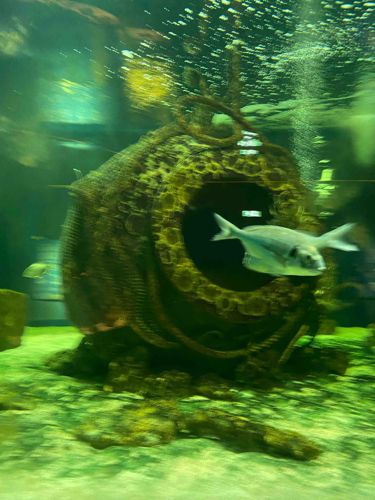
Roman Dolium (Terracotta Storage Vessel)
The item depicted is a large, spherical terracotta container, identified as a dolium, now submerged and displayed in an aquatic environment, likely an aquarium or museum exhibit. Its primary material is terracotta, which has aged significantly, presenting a mottled, organic texture with visible accretion of marine growth, including possibly algae, barnacles, or other sedentary organisms, giving it a green and brown overall hue. The dolium is remarkably large, measuring approximately 1.60 meters in height and about 4.50 meters in width at its broadest section. It features a substantial opening on one side, large enough for fish to swim through, suggesting either a deliberate design feature or a result of breakage over time. The surface shows considerable wear consistent with prolonged submersion and recovery from the sea. There are no clear visible manufacturer's marks or signatures, which is typical for ancient utilitarian vessels of this kind. The construction appears robust, designed for high capacity, estimated to hold between 1500-2000 liters, as indicated by the context. The overall shape is bulbous, tapering towards a narrower base or neck, though the base is obscured by the seabed and additional marine debris on which it rests. It is clear that the item has been recovered from a marine archaeological context, specifically from the sea of Monopoli (BA), linking it to Roman antiquity. The craftsmanship, while functional, reflects the robust and practical nature of Roman pottery for storage purposes, prioritizing volume and durability over intricate decoration.
AI-Generated Appraisal Disclaimer
Estimated Value
$150,000 - $250,000
Basic Information
Category
Ancient Artifact - Storage Vessel
Appraised On
November 28, 2025
Estimated Value
$150,000 - $250,000
Additional Details Provided By Owner
User Provided Information
polium recovered in the sea of Monopoli (BA): Romam adre. Spherkal terracotta container, 1.60 meters high and about 4.50 meters wide on the largest section, is mainly used for wine Tu had a capacity of around 1500-2000 litres:
Item Description
The item depicted is a large, spherical terracotta container, identified as a dolium, now submerged and displayed in an aquatic environment, likely an aquarium or museum exhibit. Its primary material is terracotta, which has aged significantly, presenting a mottled, organic texture with visible accretion of marine growth, including possibly algae, barnacles, or other sedentary organisms, giving it a green and brown overall hue. The dolium is remarkably large, measuring approximately 1.60 meters in height and about 4.50 meters in width at its broadest section. It features a substantial opening on one side, large enough for fish to swim through, suggesting either a deliberate design feature or a result of breakage over time. The surface shows considerable wear consistent with prolonged submersion and recovery from the sea. There are no clear visible manufacturer's marks or signatures, which is typical for ancient utilitarian vessels of this kind. The construction appears robust, designed for high capacity, estimated to hold between 1500-2000 liters, as indicated by the context. The overall shape is bulbous, tapering towards a narrower base or neck, though the base is obscured by the seabed and additional marine debris on which it rests. It is clear that the item has been recovered from a marine archaeological context, specifically from the sea of Monopoli (BA), linking it to Roman antiquity. The craftsmanship, while functional, reflects the robust and practical nature of Roman pottery for storage purposes, prioritizing volume and durability over intricate decoration.
Related Tags
Get Your Items Appraised
Instant estimates of your treasures with AI-powered instant appraisals